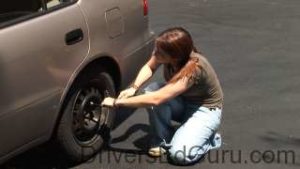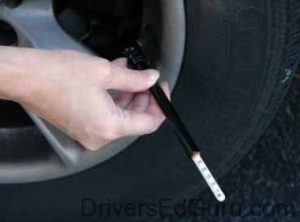Stage 1: Tire Talk

As far as car maintenance is concerned, tires are typically the most neglected part of a vehicle. Yet, proper tire maintenance can increase your gas mileage, drastically prolong the life of your tires, and prevent crashes due to tire failure.
At some point, your teen is going to be a responsible adult member of society and needs to know how to take care of their tires. There’s a tendency to believe that all you have to do to take care of a car is to put gas in it.
It’s your responsibility to teach your teen that machines that cost tens of thousands of dollars usually can’t maintain themselves.
Your tire footprint
Your tires are the only thing keeping your car on the road and driving safely. A tire’s footprint, or the area that is actually in contact with the road, is quite small. In fact, it’s less than a square foot per tire. This tiny tire footprint is what creates the traction that allows your car to accelerate, decelerate, and turn. If these contact points are hampered by poor tread or underinflation, your ability to steer, start, and stop can be adversely affected.
Thus, it’s important that your tires are properly inflated and the tread is in good condition. Even one tire that is out of whack can wreak havoc at any moment without warning.
Changing a tire
If you don’t know how to change a fat tire, you shouldn’t be driving a car. We also believe everyone should have a AAA membership. But, you may have a blowout in the middle of Nebraska at 2 AM. Being able to take care of this yourself instead of having to wait two hours for the nearest driver to arrive is well worth the time it takes to learn this skill.

Checking tire pressure
You cannot tell if a tire is underinflated by looking at it. Merely looking at a tire can only tell you if it’s completely flat. However, underinflation can be just as serious and detecting it can only be done with a quality tire gauge.
Your tire pressure is also affected by the temperature of the tire. If you remember from physics, you can increase the pressure of a gas by heating it up. You can heat something up by applying friction. So, driving your car heats up your tires, and thus increases the pressure inside them.
The suggested ratings which are written on the outside of your tire are based upon a “cold” tire.
A cold tire is one that hasn’t been driven for at least three hours or has driven less than a mile. If you stop at a gas station and determine that your tires are underinflated, add air until you reach the recommended PSI (pounds per square inch) which is written on the side of your tire. If your tire isn’t “cold”, don’t try to guess how much extra air to add. Simply wait until you can adjust the PSI of the tire when it hasn’t been driven more than a mile.
The short video below should help reinforce some of these concepts regarding tire pressure:
Tires lose pressure over time
The warmer the weather, the quicker your tires naturally lose pressure. It’s not uncommon to loose 10 pounds of tire pressure throughout the summer simply due to normal driving. This loss of pressure is enough to cause traction problems, uneven tread wear, and tire failure.
Eight pounds below means “substantially underinflated”
A tire that is 8 PSI below the recommended level is considered a safety hazard. So, check your tire pressure often. All cars made in 2008 and beyond feature government-mandated tire pressure sensors that will cause a dashboard warning light to illuminate if tire pressure falls too low. If your car is older than a 2008, there are gadgets you can buy that you attach to your tires which keep a constant eye out on your tire pressure.

Checking tire tread
If your tires are bald, you might as well be driving with blocks of ice for tires. Well, maybe that’s an exaggeration, but you get the point. Poor tread reduces your traction in the same way that a slippery road would. So, check your tread often to make sure that you have at least 1/8″ remaining.
You should also check for uneven wear which may be an indication that you need to rotate your tires or have them replaced.
In the picture to the right, you can see that tire tread can be checked by using a quarter. If you can see the top of Washington’s head, then you don’t have enough tread.
One last video on tire pressure and tire tread
In case you haven’t noticed, we’re pretty keen on drilling into your head (and your teen’s head) the importance of proper tire pressure and tire tread. Check out the video below for a little more reinforcement.
Continue on to Become a Smooth Operator

